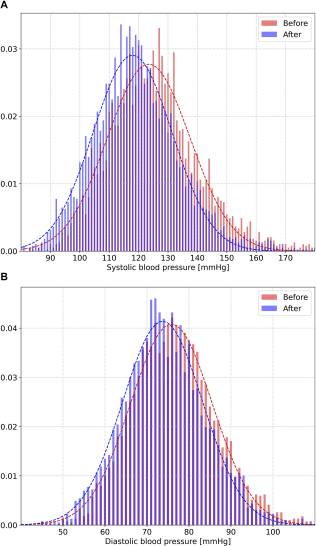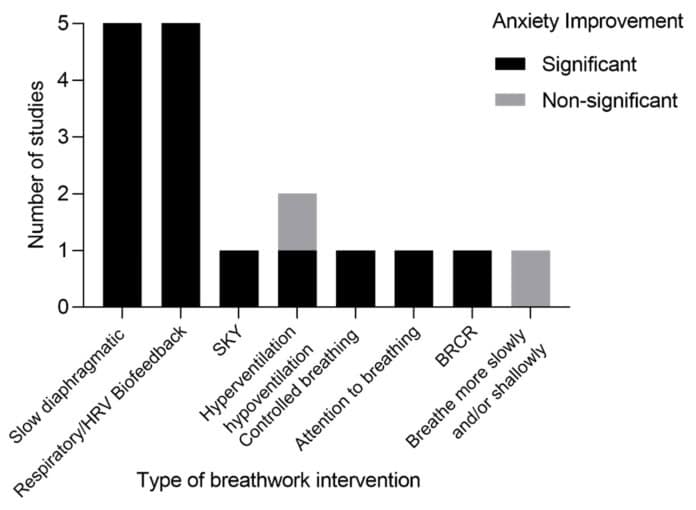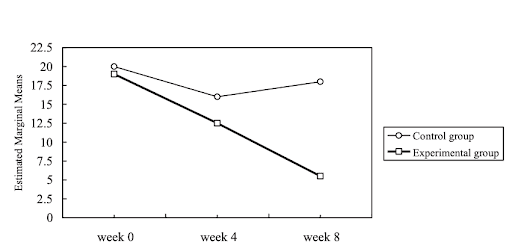
Rupali Lal
Bachelor of Pharmacy (Hons), Functional Nutritional Therapy Practitioner, Pause Breathwork Facilitator, Restorative Wellness Practitioner, RESTART® instructor
Jump to:
Interestingly, our lungs are the only organs that we can directly control, even though breathing typically happens without conscious thought.
Since studies have shown that slow breathing can positively affect our
- brain health
- cardiovascular health
- gastrointestinal health
- mental health
we should reflect and wonder how we are breathing during the course of the day.
In this article, we’ll explore the benefits of slow breathing and how even short slow breathing exercises can have a positive impact on our overall health.
Slow Breathing
Slow breathing, or slow deep breathing (SDB), is often defined as taking about six breaths per minute.[1] Some studies refer to “diaphragmatic breathing”, which involves slow and deep breathing through the nose, generally inhaling and exhaling for approximately six seconds each.
This practice influences the brain and
- cardiovascular system
- respiratory system
- gastrointestinal system
by modulating autonomic nervous functions.
Slow breathing is defined as taking about six breaths per minute
The diaphragm’s connection with the vagus nerve means that diaphragmatic breathing can suppress sympathetic nervous activity (the “fight or flight” response) and activate parasympathetic nervous activity (the “rest and digest” response).[2]
Brain Health
Mental clarity, focus and memory are essential for productivity and overall well-being.
A study involving 45 elderly participants evaluated the impact of deep slow breathing on newly acquired basic cognitive functions of learning and memory (using Stroop test).[3]
Participants were divided into three groups:
- rest group (RG)
- before group (BG)
- after group (AG)
Cognitive abilities were measured before the test, 30 minutes after learning, and 24 hours after learning. The BG performed deep and slow breathing for 30 minutes before learning new skills, while the AG did so afterward.
The findings suggested that deep slow breathing significantly improved retention of these functions, especially in the long-term test conducted 24 hours later.
In the BG, the percentage of correct responses increased from 45% during the initial task to 81.5% in the short-term test and 86.25% in the long-term test—an improvement of approximately 81.7%.
The AG improved from 51% to 89%—a 74.5% improvement. Reaction times also improved, with the BG showing a 16% decrease and the AG a 26.5% decrease.
This study used alternate nostril breathing 6–8 times per minute for 30 minutes using a 2:2:4 breathing cycle.
Due to the vagus nerve excitation, deep slow breathing stimulates release of neurochemicals such as acetylcholine and epinephrine, which has a positive impact on:
- neurogenesis (growth and development of nervous tissue)
- neuroplasticity (rewiring of the brain)
- neuronal repair
all of which improve retention of skill learning.[3]
RELATED — Introduction to: Brain Health
Another study at a hospital ward in Nepal was performed to observe the immediate effect of 5 minutes of slow deep breathing (4 seconds inhalation, 6 seconds exhalation) on reaction time in a total of 80 patients.[4]
They used an online visual reaction time test and found a significant reduction in reaction time, with an average improvement of about 15%. The improved concentration is possibly due to the ability to ignore external stimuli or faster information processing.
Cardiovascular Health
Slow breathing has significant benefits for cardiovascular health. A scoping review published in 2023 analysed 339 articles, of which 20 studies on breathing exercises for hypertensive patients were included. Almost all studies demonstrated positive effects, suggesting that such practices could be recommended by healthcare providers.[5]
One specific study found that breathing at a rate of 6 breaths per minute for 15 minutes a day, guided by a hypertension app on a Fitbit, effectively lowered blood pressure both immediately but also over the 28 day study duration.[1]
Participants with systolic pressure ≥ 130 mmHg experienced a decrease of 9.7 mmHg after 15 minutes and an average reduction of 4.3 mmHg over several days.

Another study involving a hundred participants with pre-existing hypertension found slow breathing to be more effective than mental relaxation at reducing
- systolic (~36%) and diastolic (~96%) blood pressure
- heart rate (~65%)
- respiratory rate (~71%)
This is done via increasing parasympathetic tone.[6]
Variables were measured at resting state and then during mental relaxation and slow breathing for 10 min each, separated by a quiet period of 15 min. Breathing was maintained at 6 breaths a minute.
Gastrointestinal Health
As we now understand, slow breathing activates the parasympathetic nervous system, bringing the body into its “rest and digest” state.
This contrasts with sympathetic nervous system dominance, where the body is primed for “fight or flight,” temporarily shutting down non-essential functions like digestion and reproductive processes. The impact of slow breathing is demonstrated in the following three scenarios.
In a study of patients with nonerosive gastroesophageal reflux disease (GERD), 19 participants were divided into two groups:
- 10 practiced daily deep breathing for 30 minutes
- 9 were in a control group[2]
After four weeks, those in the deep breathing group saw their acid exposure time drop from 9.1% to 4.7%, and their quality of life (QoL) scores improved by 19%.
After nine months, continued deep breathing reduced proton pump inhibitor usage by 74% and further improved QoL scores by 36%. No significant changes were observed in the control group.[2]
Another study involved 85 patients with IBS-C (Irritable Bowel Syndrome with Constipation), split into two groups:
- 42 in the experimental group
- 43 in the control group
whereby the experimental group practiced slow deep breathing at six breaths per minute for 30 minutes per session for 6 weeks.[7]
The experimental group had:
- Significantly lower constipation scores (25% improvement)
- Significantly more weekly spontaneous bowel movements (47% increase)
- Significantly more weekly complete spontaneous bowel movements (23% increase)
Improved symptoms of stool consistency and the frequency of bowel movements and also altered rectal sensitivity is likely mediated via vagal activity enhancement as indicated by heart rate variability measures.[7]
Slow breathing can assist with IBS
Lastly, in a study of 60 motion sickness susceptible subjects, the impact of slow breathing on motion sickness was investigated in a virtual reality environment (10-min fluctuating view of a stormy sea).
It was found that compared to the control group, the slow breathing group had lower respiration rate and high heart rate variability.
Their self-reported motion sickness was reduced by about 24%, and their scores on a motion sickness questionnaire were lower by about 27%.[2]
Mental Health
Chronic stress can lead to numerous health problems. It has been said that altering breathing patterns can account for at least 40% of the variance in feelings of anger, fear, joy, and sadness.[8]
The diagram below shows how stress activates the sympathetic nervous system, increasing heart rate and bronchial dilation, and how slow diaphragmatic breathing counteracts these effects.[9]

A review of studies on different breathwork styles and their impact on anxiety found that slow diaphragmatic breathing, featured in five (31%) studies, showed significant improvement in reducing anxiety.[9]
RELATED — Introduction to Anxiety: Know what you are dealing with (Part 1)

(significant or not significant).
Abbreviations: breathing retraining cognitive restructuring (BRCR), Surdashan Kriya Yoga (SKY), and heart rate variability-biofeedback (HRV-BF).
A randomised controlled study on 40 participants found that intensive diaphragmatic breathing training in the intervention group of 20 participants (20 sessions over 8 weeks at an average rate of 4 breaths/min) led to a significant decrease in cortisol levels, with a 13.9% reduction from baseline.[10]
Since cortisol is associated with stress, anxiety, and negative emotions, this reduction is particularly noteworthy.
Another study showed that subjective anxiety decreased by about 13% among both young and older adults after just 5 minutes of slow deep breathing.[11]
This exercise used a longer exhalation (4 seconds in, 6 seconds out) to enhance parasympathetic activity and relaxation, with physiological stress (measured by heart rate variability, specifically High Frequency band) decreasing more in older adults.
Lastly, 30 participants completed an 8 week course with
- 15 in the diaphragmatic breathing group
- 15 in the control[12]
The anxiety level, based on Beck Anxiety Inventory (BAI) scores in the experimental group decreased by 33.77% from Week 0 to Week 4, and by an additional 57.91% from Week 4 to Week 8, resulting in an overall reduction of 72.11% from the start of the study to Week 8 while the control group made no statistically significant progress.
Consistent slow breathing exercise can reduce anxiety symptoms by 30%

Of note, there was also significant progress in reducing anxiety as measured physiologically; skin conductivity, heart rate, and breathing rate.
Respiratory Health
Slow breathing is definitely beneficial for the organ system where it takes place i.e. the respiratory system.
A systematic review of 19 randomized controlled trials on chronic obstructive pulmonary disease (COPD) patients found that breathing exercises improved respiratory function, such as reducing the respiratory rate by an average of 1.09 breaths per minute.[2]
However, their effects on clinical symptoms and quality of life were inconsistent due to the severity stage of COPD.
Since patients with COPD show significant sympathetic nerve activity, one study found that slow breathing at 6 breaths per minute significantly reduced sympathetic activity by around 13.5% in COPD patients.[13]
They concluded that given the negative consequences of sympathetic activation, using slow breathing to bring balance might have the potential to impact on systemic effects in COPD patients.

White: spontaneous breathing, Grey: respiratory rate 15 breaths/min, Black: respiratory rate 6 breaths/min.
Another study involving 183 asthma patients compared a breathing training group (94 participants) with an asthma education group (89 participants).[14]
The study lasted for six months, with assessments conducted at one month and six months. At one month, both groups showed similar improvements in quality of life (based on a questionnaire score).
However, at six months, the breathing training group improved by 14%, compared to 9.3% in the control group.

While quality of life improved, there was no change in airway inflammation, suggesting that breathing training should complement, not replace, anti-inflammatory medication.
Related Questions
1. Why are fast breathing methods used for stress and transformation?
While it may sound contradictory, “temporarily and voluntarily induced stress, such as short-term stress induced by exercise, fast breathing techniques, or cold exposure, can have long-term positive effects on reducing stress and improving mental health”.[9]
It is known to build resilience over time as one learns to regulate their breathing and internal state in a safe, guided environment, attaining a sense of control.[15]
2. What is the best breathing technique to do before sleep?
Best breathing exercise before napping or sleeping is slow deep breathing.
A study confirmed that SDB 20 mins prior to sleep, helped individuals with insomnia by reducing the time required to fall asleep and improving sleep quality as it results in melatonin production, a sleep-inducing hormone.[16,17]
For similar articles, please see our Relaxation section.
References
(1) Natarajan, A., Emir-Farinas, H., & Su, H. (2023). Mindful breathing as an effective technique in the management of hypertension. Front Physiol. doi: 10.3389/fphys.2023.1339873
(2) Hamasaki, H. (2020). Effects of Diaphragmatic Breathing on Health: A Narrative Review. Medicines (Basel). doi: 10.3390/medicines7100065
(3) Lee, S.H., Park, D.S., & Song, C.H. (2023). The Effect of Deep and Slow Breathing on Retention and Cognitive Function in the Elderly Population. Healthcare (Basel). doi: 10.3390/healthcare11060896
(4) Manandhar, S.A., Pramanik, T. (2019). Immediate Effect of Slow Deep Breathing Exercise on Blood Pressure and Reaction Time. Mymensingh Med J.
(5) Herawati, I., Mat Ludin, A. F., Mutalazimah, M., Ishak, I., & Farah, N. M. F. (2023). Breathing exercise for hypertensive patients: A scoping review. Front Physiol. doi: 10.3389/fphys.2023.1048338
(6) Kaushik, R. M., Kaushik, R., Mahajan, S. K., & Rajesh, V. (2006). Effects of mental relaxation and slow breathing in essential hypertension. Complementary Therapies in Medicine.
(7) Jokerst, M. D., Gatto, M., Fazio, R., Stern, R. M., & Koch, K. L. (1999). Slow deep breathing prevents the development of tachygastria and symptoms of motion sickness. Aviat Space Environ Med.
(8) Brown, R. P., & Gerbarg, P. L. (2009). Yoga Breathing, Meditation, and Longevity. Annals of the New York Academy of Sciences.
(9) Banushi, B., Brendle, M., Ragnhildstveit, A., Murphy, T., Moore, C., Egberts, J., & Robison, R. (2023). Breathwork Interventions for Adults with Clinically Diagnosed Anxiety Disorders: A Scoping Review. Brain Sci.
(10) Ma, X., Yue, Z.-Q., Gong, Z.-Q., Zhang, H., Duan, N.-Y., Shi, Y.-T., Wei, G.-X., & Li, Y.-F. (2017). The Effect of Diaphragmatic Breathing on Attention, Negative Affect and Stress in Healthy Adults. https://doi.org/10.3389/fpsyg.2017.00874
(11) Magnon, V., Dutheil, F., & Vallet, G. T. (2021). Benefits from one session of deep and slow breathing on vagal tone and anxiety in young and older adults. Sci Rep. doi: 10.1038/s41598-021-98736-9
(12) Chen, Y.-F., Huang, X.-Y., Chien, C.-H., & Cheng, J.-F. (2016). The Effectiveness of Diaphragmatic Breathing Relaxation Training for Reducing Anxiety. Perspect Psychiatr Care.
(13) Raupach, T., Bahr, F., Herrmann, P., Luethje, L., Heusser, K., Hasenfuß, G., Bernardi, L., & Andreas, S. (2008). Slow breathing reduces sympathoexcitation in COPD. Eur Respir J.
(14) Thomas, M., McKinley, R. K., Mellor, S., Watkin, G., Holloway, E., Scullion, J., Shaw, D. E., Wardlaw, A., Price, D., & Pavord, I. (2008). Breathing exercises for asthma: a randomised controlled trial. Thorax. https://doi.org/10.1136/thx.2008.100867
(15) Bentley, T. G. K., D’Andrea-Penna, G., Rakic, M., Arce, N., LaFaille, M., Berman, R., Cooley, K., & Sprimont, P. (2023). Breathing Practices for Stress and Anxiety Reduction: Conceptual Framework of Implementation Guidelines Based on a Systematic Review of the Published Literature. Brain Sci. doi: 10.3390/brainsci13121612
(16) Tsai, H.J., Kuo, T. B. J., Lee, G.-S. & Yang, C. C. H. (2015). Efficacy of paced breathing for insomnia: Enhances vagal activity and improves sleep quality. Psychophysiology.
(17) Jerath, R., Beveridge, C., & Barnes, V. A. (2018). Self-Regulation of Breathing as an Adjunctive Treatment of Insomnia. Front Psychiatry. doi: 10.3389/fpsyt.2018.00780






